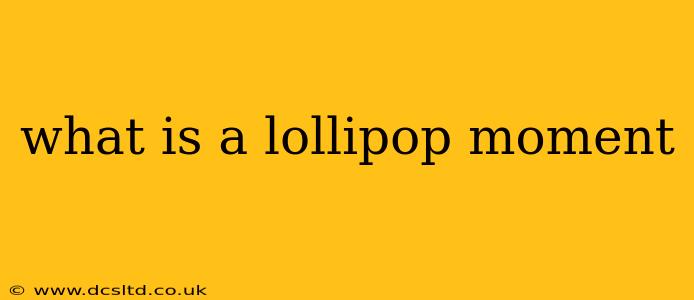In the bustling world of user experience (UX) design, the term "lollipop moment" refers to a small, unexpected, and delightful surprise that enhances a user's interaction with a product or service. It's a moment of pure joy, a tiny spark of happiness that elevates the overall experience beyond mere functionality. Think of it as a digital equivalent of receiving an unexpected lollipop – a little something extra that makes the day a bit sweeter.
These moments aren't about grand gestures or revolutionary features. Instead, they focus on the subtle details that create a positive emotional connection with the user. They are often playful, quirky, and personalized, leaving a lasting positive impression. Essentially, it's about injecting fun and delight into the user journey.
What Makes a Moment a "Lollipop Moment"?
Several key characteristics define a successful lollipop moment:
- Unexpectedness: It shouldn't be something the user anticipates. The surprise element is key to its effectiveness.
- Delightful: It must be positive and enjoyable, leaving the user feeling good.
- Small but significant: It doesn't need to be a major feature; a subtle detail can be just as impactful.
- Relevant: The moment should be connected to the context of the user's interaction. A random, unrelated surprise might feel out of place.
- Personalized (optional): While not always necessary, a personalized lollipop moment can create an even stronger connection with the user.
Examples of Lollipop Moments
Let's explore some real-world examples across different platforms:
- Gaming: Unlocking a hidden achievement with a fun animation or celebratory sound effect.
- E-commerce: A small animated confetti shower after a successful purchase.
- Social Media: A personalized birthday greeting or a fun filter celebrating a milestone.
- Apps: A playful loading animation that keeps users engaged while waiting.
- Websites: A subtle animation triggered by a user interaction, like a bouncing button or a playful character appearing.
How to Design Effective Lollipop Moments
Creating effective lollipop moments requires careful planning and consideration:
- Understand your audience: What would resonate with your users? Their preferences and expectations will dictate the type of surprise that will be most effective.
- Keep it simple: Overly complicated or confusing moments can be counterproductive. Aim for simplicity and clarity.
- Test and iterate: Experiment with different types of lollipop moments to see what works best. Gather user feedback to refine your approach.
- Don't overdo it: Too many lollipop moments can dilute their impact. Use them sparingly to maximize their effectiveness.
Is it just a gimmick? The value beyond the "sweetness."
While seemingly frivolous, lollipop moments serve a valuable purpose. They contribute to:
- Increased user engagement: Delightful experiences encourage users to spend more time with the product or service.
- Improved brand perception: Positive emotional associations enhance brand loyalty and advocacy.
- Enhanced user satisfaction: Small joys accumulate to create a positive overall experience.
- Boosted word-of-mouth marketing: Memorable lollipop moments often lead to positive reviews and referrals.
Frequently Asked Questions
What's the difference between a lollipop moment and a micro-interaction?
While both involve small, delightful details, lollipop moments tend to be more unexpected and playful, while micro-interactions are typically more functional and focused on providing immediate feedback to user actions. A lollipop moment is often a type of micro-interaction, but not all micro-interactions are lollipop moments.
Are lollipop moments only for consumer-facing products?
No, lollipop moments can be incorporated into internal tools and applications to boost employee morale and engagement. A fun animation celebrating a project completion, for example, can be highly effective.
How can I measure the success of a lollipop moment?
Tracking metrics like user engagement, session duration, and positive feedback can help assess the effectiveness of a lollipop moment. Qualitative feedback through user surveys or interviews is also invaluable.
By carefully crafting and implementing lollipop moments, designers can create truly memorable and delightful user experiences that leave a lasting positive impression. It's about adding that extra sprinkle of magic to make the interaction truly special.
